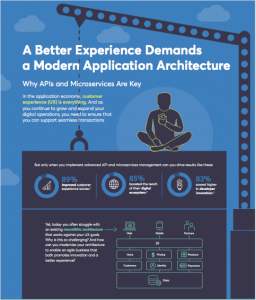Originally Published on Intellyx
If you’re a business leader today, there is one thing that should be at the top of your priority list: business agility.
In the age of digital disruption, it is no longer the big or strong that survive — it is the most agile.
Business leaders now accept the need for agility to stave off disruptive threats. The question, however, is how? Saying you need to be agile is easy. Becoming agile is proving much more difficult.
As the modern enterprise seeks to create agility in its business models, operating structures, and business processes, it often finds itself rigidly bound to legacy applications that they deployed to automate or manage them. The result is application inertia that inhibits their ability to adapt and create the organizational agility they so desperately need.
This challenging state has led many organizations to attempt to develop their way out of the mess. They have erroneously thought that they could merely create a new top-layer of modern applications that would mask the inherent inflexibility in their legacy application architecture.
While these efforts may create a shiny new veneer, this approach does not deliver the business agility enterprises seek. Instead, business leaders are recognizing that to realize the agility they need to compete in today’s world, they must modernize their full application architecture.
MODERNIZING YOUR APPLICATION ARCHITECTURE TO DRIVE BUSINESS AGILITY
The reason that the modernization of the application architecture is central to enabling business agility comes down to one thing: the customer.
Organizations built traditional applications from the perspective of their operational needs. The focus was on efficiency and optimization, and the applications were, therefore, organized according to functional silos: one system for each function.
The problem is that a customer does not care about an organization’s functional silos — and in the era of digital disruption, the customer is the only thing that counts.
Creating a positive customer experience and meeting their needs throughout the customer journey are now the primary drivers of business value and competitive differentiation. The challenge, of course, is that customer expectations can change rapidly based on shifts in the market and disruptive upstarts. Thus, the need for business agility.
Enterprise organizations must, therefore, re-envision their application architecture from the ground up to enable them to rapidly assemble, disassemble and reassemble application components so that they can adapt their business models, operating structures and business processes to the changing demands of the customer.
Enterprises are building these new adaptive application architectures using modern approaches such as microservices and containers, but doing so increases architectural complexity and can introduce manageability and security risks.
WHY API MANAGEMENT IS AT THE HEART OF APPLICATION MODERNIZATION
Customers want a seamless experience. Organizations are responding by modernizing their application architectures — but as they do so at scale, they are rapidly introducing manageability issues that threaten to undermine the customer experience they are trying to enhance.
For this reason, business and IT leaders are turning to a very technical sounding solution to this challenging business problem: API management.
Application Programming Interfaces (APIs) is a technical term for a pre-defined set of instructions that enable one application to communicate with another. As organizations turn to approaches like microservices, which essentially deconstructs applications into modular components, APIs become the glue that connects them and enables data to move fluidly throughout a business process and customer interaction.
The creation, publishing, consumption, and management of APIs, therefore, becomes a critical enabler of both application modernization and the business agility that organizations seek. While organizations can produce and manage APIs independently, this exacerbates the complexity and inhibits the agility that is the reason for these new architectures in the first place.
Organizations are, therefore, turning to API management platforms, like CA’s API management suite, which enable them to manage the full API lifecycle from creation through consumption. Taking this approach, organizations can create an adaptable application architecture, but overcome the manageability and complexity risks of doing so.
THE INTELLYX TAKE
When business leaders think about creating business agility and responding to disruptive threats, application architectures and API management are probably not the first things that come to mind. In fact, diving into this seemingly technical level of detail will seem uncomfortable for most business executives.
The reality, however, is that applications now lie at the center of the customer experience and, therefore, are at the heart of every organization’s business model. Consequently, every business leader is also leading what CA calls a modern software factory.
As such, business leaders must play a central role in the modernization of their application architecture that is now at the core of their business. They must also ensure that they employ management approaches that protect and foster the agility they have created.
While it is tempting to view these as merely technical problems and solely the responsibility of IT, the stakes are just too high for business leaders to take such a hands-off approach. Together, business leaders and their IT functions must ensure that such architectures enable them to leverage emerging technologies, respond to disruptive threats and find new routes to market.
Copyright © Intellyx LLC. CA is an Intellyx client. Intellyx retains full editorial control over the content of this paper.

